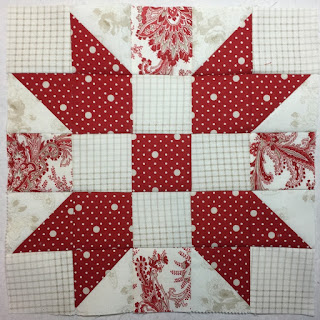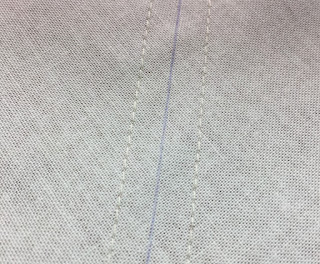Today, I have finally found a few minutes to hastily write up this pattern.
 | |||
| Sara Quilt, Block 7. 10 1/2" x 10 1/2" |
You will need four fabrics, two creams, one main red, and one contrast red.
From the main red, cut:
- Five squares 2 1/2" x 2 1/2"
- Four squares 3 1/4" x 3 1/4"
From the contrast red, cut:
- Four squares 2 1/2" x 2 1/2"
From Cream 1, cut:
- Four squares 2 1/2" x 2 1/2"
From Cream 2, cut:
- Four squares 3 1/4" x 3 1/4"
Make eight half square triangles.
1. Draw a diagonal line from corner to corner on the wrong side each of the 3 1/4" x 3 1/4" Cream 2 squares.
2. Align one of these squares on top of each of the 3 1/4" x 3 1/4" red squares, right sides together.
3. Stitch 1/4" from either side of the drawn line.
4. Cut on the line and open the half square triangles.
5. Press to the red. The patches will be slightly larger than needed.
 |
| I made two versions of this block. The fabrics shown here are used in the second version. |
Assemble the block.
1. Make rows 1 and 5, the top and bottom rows of the block. From left to right: Cream 1 square, half square triangle, contrast red square, half square triangle, Cream 1 square.
2. Make rows 2 and 4. From left to right: half square triangle, red square, Cream 1 square, red square, half square triangle.
3. Make the middle row. From left to right: contrast red square, Cream 1 square, red square, Cream 1 square, contrast red square.
4. Assemble as show above. Be very careful to place the half square triangles in the right position or ...
.... you just might wind up with an undesirable block!
I did take it apart and fix it. This quilt is for my granddaughter, and I really didn't like the accidentally invented block.
Now, on to writing up the pattern for Block 5, the final block pattern for Sara's quilt.
First, though, I'm going for a walk. It's such a beautiful day.
 |
| Sunshine in our little neighborhood park. |
Wishing you a beautiful day!














































